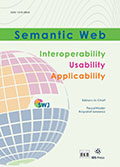Authors: Giustozzi, Franco | Saunier, Julien | Zanni-Merk, Cecilia
Article Type:
Research Article
Abstract:
In Industry 4.0, factory assets and machines are equipped with sensors that collect data for effective condition monitoring. This is a difficult task since it requires the integration and processing of heterogeneous data from different sources, with different temporal resolutions and underlying meanings. Ontologies have emerged as a pertinent method to deal with data integration and to represent manufacturing knowledge in a machine-interpretable way through the construction of semantic models. Ontologies are used to structure knowledge in knowledge bases, which also contain instances and information about these data. Thus, a knowledge base provides a sort of virtual representation of the
…different elements involved in a manufacturing process. Moreover, the monitoring of industrial processes depends on the dynamic context of their execution. Under these circumstances, the semantic model must provide a way to represent this evolution in order to represent in which situation(s) a resource is in during the execution of its tasks to support decision making. This paper proposes a semantic framework to address the evolution of knowledge bases for condition monitoring in Industry 4.0. To this end, firstly we propose a semantic model (the COInd4 ontology) for the manufacturing domain that represents the resources and processes that are part of a factory, with special emphasis on the context of these resources and processes. Relevant situations that combine sensor observations with domain knowledge are also represented in the model. Secondly, an approach that uses stream reasoning to detect these situations that lead to potential failures is introduced. This approach enriches data collected from sensors with contextual information using the proposed semantic model. The use of stream reasoning facilitates the integration of data from different data sources, different temporal resolutions as well as the processing of these data in real time. This allows to derive high-level situations from lower-level context and sensor information. Detecting situations can trigger actions to adapt the process behavior, and in turn, this change in behavior can lead to the generation of new contexts leading to new situations. These situations can have different levels of severity, and can be nested in different ways. Dealing with the rich relations among situations requires an efficient approach to organize them. Therefore, we propose a method to build a lattice, ordering those situations depending on the constraints they rely on. This lattice represents a road-map of all the situations that can be reached from a given one, normal or abnormal. This helps in decision support, by allowing the identification of the actions that can be taken to correct the abnormality avoiding in this way the interruption of the manufacturing processes. Finally, an industrial application scenario for the proposed approach is described.
Show more
Keywords: Semantic technologies, ontology, context modeling, stream reasoning, condition monitoring, Industry 4.0
DOI: 10.3233/SW-233481
Citation: Semantic Web,
vol. 15, no. 2, pp. 583-611, 2024





